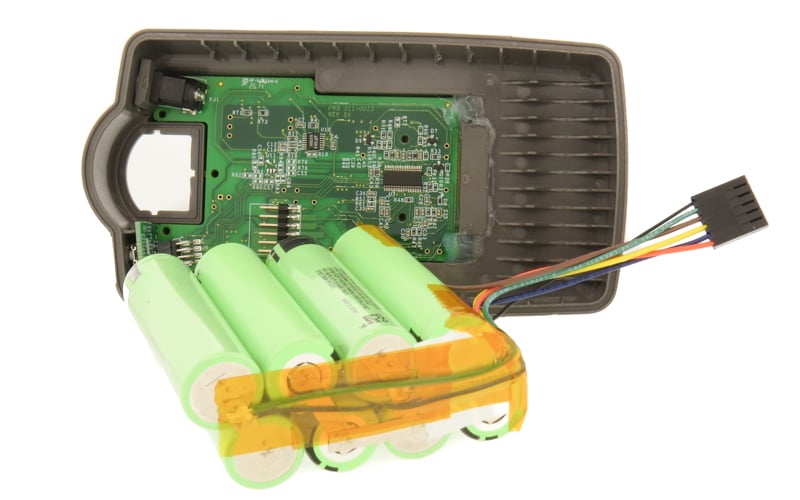Battery power requirements involve many factors. Beyond having enough power to run the application, customers also take into consideration battery capacity, charging/discharging rates, and environmental conditions that could impact the battery's functions. Before the battery packs development starts, there are other aspects about the power requirements that need to be evaluated. These aspects may impact the size of the battery, if there are any logistical restrictions that come into play and what types of certifications are required.
Dimensional Size Considerations
Certain battery power requirements will need to focus on voltage, amp hours, and run times. The amount of power that can be packed into the battery cell (density) and its lifecycle will dictate the type of battery chemistry that you select and the number of battery cells that are needed to obtain the correct voltage.
For example, an electronic device that requires a cell voltage of 3.6V may obtain this by using nickel cadmium (NiCd), nickel metal hydride (NiMH), or lithium-based chemistries. Both NiCd and NiMH batteries have a voltage of 1.2V, while the lithium batteries have a voltage of 3.6V. To reach the appropriate voltage, a customer may have to use 3 NiCd or NiMH cells versus the 1 lithium cell.

Example of battery pack enclosure, BMS, cells and harness during assembly process.
This factor is important when taking the dimensional size of the application into consideration. The more cells that are added to achieve the specified voltage, the heavier and larger the battery pack becomes. If the electronic device needs to be lightweight and small, the fewest and lightest batteries that still offer the 3.6V makes more dimensional sense, as the customer may select lithium-based chemistry. However, in certain circumstances, a lithium-based chemistry may not be suitable due to its thermal instability. During the development and design phases, the battery chemistry and voltage play a significant role in the dimensional size of the battery pack.
Logistical Restrictions and Certifications
How the battery is charged, the life cycle of the battery, and the self-discharge rate may cause logistical restrictions for the application. If the application will be used in outdoor environments or places where it will not have an accessible way to charge for long periods, the customer needs to decide on the type of battery pack that can withstand such circumstances. When developing a custom battery pack, you want to select a chemistry with a longer life cycle and a lower self-discharge rate.
Other logistical restrictions involve the use of lithium-based and NiCd chemistries for products. Many countries have regulations restricting how lithium-based batteries are handled and transported. These restrictions may limit the number of products shipped out at one time and require testing of the batteries as well as protection circuits to prevent dangerous thermal runaway from occurring. This testing must be accomplished by certifying organizations to receive the appropriate certifications. For NiCd batteries, the cadmium used in the batteries is considered an environmental hazard, making them difficult to dispose of. They are currently prohibited in Europe.
Development and Piece Cost
Battery chemistries come with different development and piece costs when discussing the power requirements for the application. Like discussing the dimensional sizes, the more cells that will be added into the battery pack to achieve the right voltage, the greater the costs will be. Also, different battery chemistries have higher prices based on the types of chemicals and metal used, the power density they offer, the self-discharge rate, and the ease of manufacturing.
Lead Acid Batteries
Lead acid chemistries offer moderate power density along with a moderate self-discharge rate. These batteries lean toward being expensive.
NiCd Batteries
NiCd batteries are very inexpensive. They have moderate density and moderate self-discharge. They can handle higher discharge rates without losing capacity.
NiMH Batteries
NiMH chemistries are also inexpensive like NiCd chemistries. Older batteries have high densities with high discharge rates. Newer chemistries offer lower densities with lower discharge rates.
Lithium-Based Batteries
Lithium-based batteries (lithium-ion, LiFeP04, and lithium-polymer) are more expensive than other battery types. They all offer higher density and lower self-discharge rates. Lithium-polymer is the only one out of the three that has lower manufacturing costs.
Development Timeline
When it comes to development timelines for the battery packs, creating custom batteries will always be dependent upon the customer's requirements. The application's power needs, and the battery chemistries selected will determine the pack design, prototyping, tooling, and testing timeframes.
For all lithium-based chemistries, lead times will be longer due to testing and certification requirements, which could take 6 to 8 weeks for UN/Dot 38.3 Transportation certification and 6 to 8 weeks for UL/IEC certification.
Always keep in mind that any changes to the battery pack enclosure, chemistry, or pack electronics will increase time frames. If certification was already obtained for lithium-based battery packs that undergo design changes later, the previous certification will not carry over to the new design. Instead, testing must begin again for the new battery design to obtain new certification.
Marketing
Marketing plays a big part in whether customer demand increases for the product or application. People want longer lasting batteries, high-power applications, low costs, and long battery life before purchasing replacement batteries. Once determining the battery pack’s power requirements, these aspects can be used in numerous marketing campaigns for further product promotion.
Customers may market their battery pack and application regarding higher energy densities for high-powered applications, lighter battery packs for portable devices, and even shorter charging times to reach full capacity. When sitting down with the engineering team and figuring out the project scope, there will be opportunities to flush out key design benefits that can be easily placed into marketing strategies.
Summary
Having a full understanding regarding the battery power requirements for your application can help assist the engineering team in designing and manufacturing your custom battery pack. The team may also offer alternatives for battery chemistry, electronics, and enclosure materials for the battery pack that may cut down on manufacturing costs as well as speed up production times.
In addition, obtaining documentation and details about the power requirements during the project scope development and refinement phases lessens the chances of production errors and may lower the need for later modifications that could increase lead times and budgets.
Key Takeaways
- Chemistry selection affects voltage, size, and weight: Choosing between lithium, NiCd, NiMH, or lead-acid chemistries determines how many cells are needed to meet voltage requirements, directly influencing the battery’s size, density, and portability.
- Regulatory and logistical limits shape design decisions: Lithium and NiCd batteries face strict transportation and environmental regulations. Understanding these early ensures compliance and helps avoid shipping delays or certification setbacks.
- Cost varies with chemistry and configuration: Each battery type comes with trade-offs in cost, density, discharge rate, and self-discharge. More cells and higher performance requirements increase both development and per-unit costs.
- Timelines depend on testing and certification: Custom lithium-based packs require additional lead time for UN/DOT 38.3 and UL/IEC testing. Any design or component change resets the certification process, extending delivery schedules.
- Marketing benefits from design insights: Power, longevity, and charging advantages identified during development can be leveraged as selling points in marketing campaigns, emphasizing efficiency, runtime, or reduced weight.
















